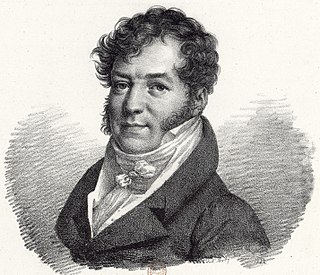
Étienne Aignan was a French translator, political writer, librettist and playwright. In 1814 he was made a member of the Académie française, succeeding Bernardin de Saint-Pierre in Seat 27. He died on 21 June 1824 aged 51 years old.

Sylvano Bussotti was an Italian composer of contemporary classical music, also a painter, set and costume designer, opera director and manager, writer and academic teacher. His compositions employ graphic notation, which has often created special problems of interpretation. He was known as a composer for the stage. His first opera was La Passion selon Sade, premiered in Palermo in 1965. Later operas and ballets were premiered at the Teatro Comunale di Firenze, Teatro Lirico di Milano, Teatro Regio di Torino and Piccola Scala di Milano, among others. He was artistic director of La Fenice in Venice, the Puccini Festival and the music section of the Venice Biennale. He taught internationally, for a decade at the Fiesole School of Music. He is regarded as a leading composer of Italy's avantgarde, and a Renaissance man with many talents who combined the arts expressively.

Pascal Georges Dusapin is a French composer. His music is marked by its microtonality, tension, and energy.

Catherine Anahid Berberian was an American mezzo-soprano and composer based in Italy. She worked closely with many contemporary avant-garde music composers, including Luciano Berio, Bruno Maderna, John Cage, Henri Pousseur, Sylvano Bussotti, Darius Milhaud, Roman Haubenstock-Ramati, and Igor Stravinsky. She also interpreted works by Claudio Monteverdi, Heitor Villa-Lobos, Kurt Weill, Philipp zu Eulenburg and others. As a recital curator, she presented several vocal genres in a classical context, including arrangements of songs by The Beatles by Louis Andriessen as well as folk songs from several countries and cultures. As a composer, she wrote Stripsody (1966), in which she exploits her vocal technique using comic book sounds (onomatopoeia), and Morsicat(h)y (1969), a composition for the keyboard based on Morse code.

Paul Armand Silvestre was a 19th-century French poet and conteur born in Paris.
Henri Léon Marie-Thérèse Pousseur was a Belgian classical composer, teacher, and music theorist.

Péter Eötvös is a Hungarian composer, conductor and teacher.

Mauro Maur, OMRI is an Italian trumpeter and composer. He has collaborated alongside musicians such as Placido Domingo, Uto Ughi, Riccardo Muti, Leonard Bernstein, Seiji Ozawa, and Pierre Boulez.
Nicholas Isherwood is a Franco-American bass singer, who specialises in contemporary and baroque music. Notable roles include "Lucifer" in the world premieres of Stockhausen’s Montag, Dienstag, and Freitag from Licht at La Scala and the Leipzig Opera, and in Donnerstag aus Licht at Covent Garden.
Liza Lim is an Australian composer. Lim writes concert music as well as music theatre and has collaborated with artists on a number of installation and video projects. Her work reflects her interests in Asian ritual culture, the aesthetics of Aboriginal art and shows the influence of non-Western music performance practice.
Francesco Filidei is an Italian concert organist and composer. A student of Salvatore Sciarrino, he has performed internationally. As a composer, he has collaborated with singer-songwriter Claire Diterzi and written operas premiered in Porto and Paris. His music has been performed by notable contemporary music ensembles. His Japanese wife, Noriko Baba, is also a composer.

Fabrizio De Rossi Re is an Italian composer and librettist. He composes operas, symphonic, choral and chamber music, and performs as a pianist.

Luciano Berio was an Italian composer noted for his experimental work, and for his pioneering work in electronic music. His early work was influenced by Igor Stravinsky and experiments with serial and electronic techniques, while his later works explore indeterminacy and the use of spoken texts as the basic material for composition.
Marilyn: Scenes from the '50s in two acts, is an opera by Lorenzo Ferrero set to a bilingual libretto by Floriana Bossi and the composer. The text consists of a collection of fragments taken from original political, social and cultural documents and has two different linguistic levels: English for the sung parts, and the language of the country in which the performance takes place for the spoken parts.
Jean-Pierre Grenier was a French actor, theatre director and screenwriter.

Berthe Dyck Kaleka called Kal was a 20th-century French soprano and music educator.

Philippe Boivin is a French contemporary composer.
Raquel Camarinha is a Portuguese operatic soprano. In 2011, she received the first prize at the Luísa Todi National Singing Competition.
Sarah Defrise is a Belgian soprano born in Brussels, Belgium.
Jean-Maurice Bourges, distinguished musical critic, translator and composer who came early to Paris to study composition under Auguste Barbereau. He became joint-editor for Revue et gazette musicale de Paris from 1839, which acquired an excellent reputation in great measure owing to him.











